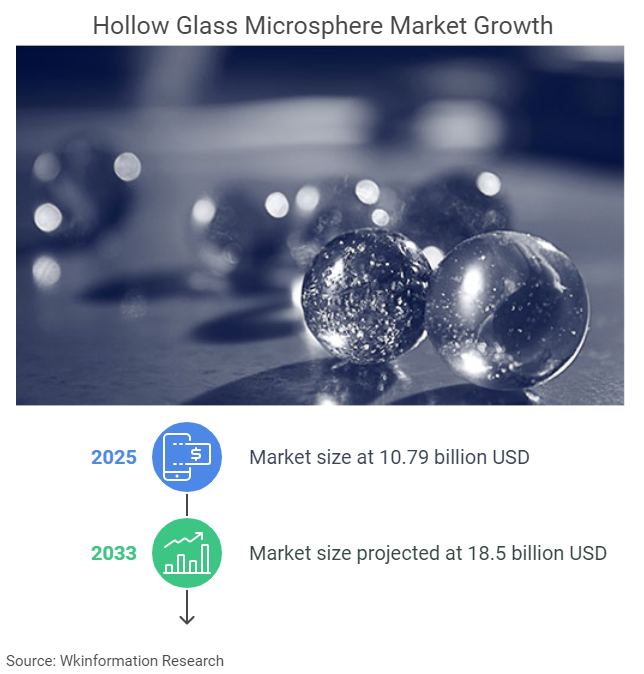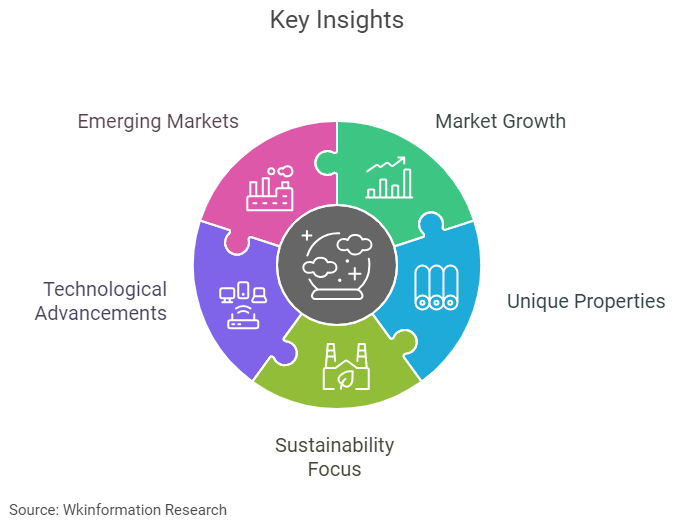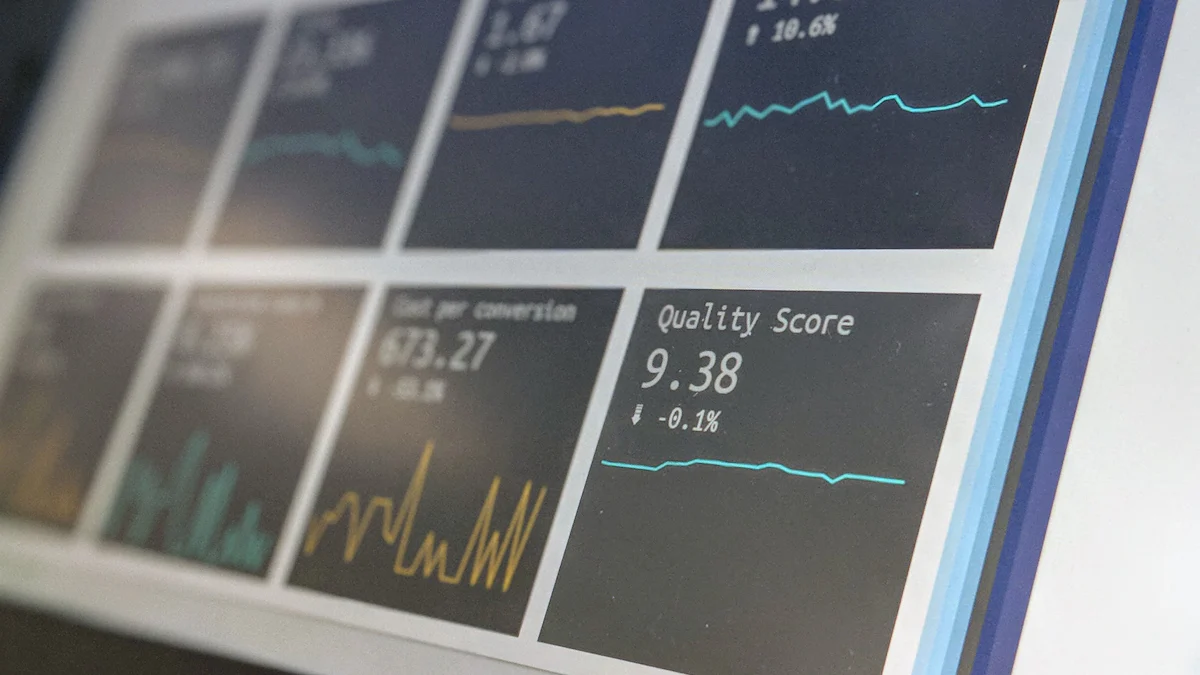
The hollow glass microsphere market has experienced remarkable growth in recent years, driven by its diverse applications across industries. Valued at approximately 10.79 billion USD in 2025, the market is projected to reach 18.5 billion USD by 2033, with a compound annual growth rate (CAGR) of 6.97%. This upward trajectory highlights its importance in delivering lightweight, high-performance materials. Industries such as automotive, aerospace, and construction increasingly rely on these microspheres to enhance efficiency and sustainability, solidifying their role as a cornerstone of modern innovation.
Key Insights
- The hollow glass microsphere market is projected to grow from approximately 10.79 billion USD in 2025 to 18.5 billion USD by 2033, driven by demand for lightweight and high-performance materials across various industries.
- Hollow glass microspheres offer unique properties such as low density, high strength-to-weight ratios, and excellent thermal insulation, making them essential in automotive, aerospace, healthcare, and construction applications.
- Sustainability is a key focus in the hollow glass microsphere market, as these materials help reduce carbon footprints and improve energy efficiency, aligning with global environmental goals.
- Technological advancements are enhancing the production and functionality of hollow glass microspheres, opening new applications in energy storage, healthcare, and innovative construction solutions.
- Emerging markets in Asia-Pacific and Latin America present significant growth opportunities for hollow glass microspheres, driven by rapid industrialization and increasing demand for sustainable materials.

Market Overview
What Are Hollow Glass Microspheres?
Hollow glass microspheres are tiny, lightweight particles made from soda-lime borosilicate glass. These spheres have a hollow structure, which gives them unique properties such as low density and high strength-to-weight ratios. Their versatility makes them a valuable material in various industrial applications. The hollow glass microsphere market has grown significantly due to their ability to enhance performance while reducing material weight.
Key Properties and Benefits
Hollow glass microspheres possess several unique properties that make them indispensable in modern industries:
- Lightweight: Their hollow structure significantly reduces weight in applications.
- High Strength-to-Weight Ratio: Despite being lightweight, they exhibit impressive compressive strength.
- Thermal Insulation: They provide excellent thermal barrier properties, improving energy efficiency.
- Chemical Stability: Their resistance to chemicals ensures durability in harsh environments.
- Low Density: At densities as low as 0.025 g/cc, they displace traditional additives like talc at a fraction of the weight.
- Mechanical and Heat Resistance: These microspheres withstand extreme mechanical stress and high temperatures.
These properties make hollow glass microspheres a cost-effective and energy-efficient solution for industries seeking lightweight, high-performance materials.
Importance in Modern Industries
Hollow glass microspheres play a critical role in advancing various industries. Their applications and benefits are summarized below:
| Industry | Applications | Benefits |
|---|---|---|
| Automotive | Lightweighting | Improved fuel efficiency |
| Aerospace | Thermal Insulation | Enhanced safety features |
| Healthcare | Drug delivery systems | Innovative solutions |
| Construction | Acoustic Insulation | Energy-efficient materials |
| Oil and Gas | Filler and Additive | Versatility in applications |
In the automotive and aerospace sectors, these microspheres contribute to lightweight designs, improving fuel efficiency and safety. In healthcare, they enable innovative drug delivery systems and medical imaging solutions. The construction industry benefits from their use in thermal and acoustic insulation, while the oil and gas sector leverages their versatility in drilling fluids and well cementing.
The hollow glass microsphere market continues to expand as industries prioritize sustainability and performance. Their lightweight and energy-efficient nature aligns with global efforts to reduce greenhouse gas emissions, further driving their adoption.
Key Trends in the Hollow Glass Microsphere Market

Technological Advancements
Recent innovations have significantly enhanced the production and application of hollow glass microspheres. Advances in fabrication techniques now enable high-quality, large-batch production, meeting the growing demand across industries. Researchers have developed methods to dope these microspheres with chemical elements, expanding their functionality for specialized uses such as microlasers, microsensors, and drug delivery systems.
In energy applications, hollow glass microspheres are gaining traction for their role in thermal insulation, solar cells, and electrical batteries. Cutting-edge research focuses on optimizing their size and usage in photonic crystal structures, which could revolutionize optical technologies. Additionally, these microspheres show promise in hydrogen storage and inertial confinement fusion, addressing environmental concerns and advancing sustainable energy solutions.
Material enhancements also play a pivotal role. For instance, silane-treated microspheres improve tensile strength by 40% and elongation at break by up to 300%. In glass-reinforced nylon 66, iM30K microspheres reduce weight and thermal expansion, minimizing part warpage. These advancements underscore the growing importance of innovation in the hollow glass microsphere market.
Increasing Demand in Automotive and Aerospace
The automotive and aerospace sectors are driving demand for hollow glass microspheres due to their lightweight and high-performance properties. In the automotive industry, these microspheres contribute to vehicle lightweighting, which improves fuel efficiency and safety. Manufacturers increasingly rely on them to meet stringent environmental regulations and consumer expectations for sustainable vehicles.
In aerospace, hollow glass microspheres are integral to lightweight aircraft components and radar systems. Their use enhances performance while reducing overall weight, a critical factor in aviation. The demand for advanced technologies in these sectors ensures the continued growth of the hollow glass microsphere market.
Regional Market Dynamics
Regional dynamics play a crucial role in shaping the hollow glass microsphere market. North America and Europe lead the market due to their advanced industries and strong focus on sustainability. These regions benefit from established automotive, aerospace, and construction sectors, which drive consistent demand.
Asia-Pacific is emerging as a high-growth region, fueled by rapid industrialization and expanding automotive and construction industries in countries like China, India, and Japan. The region’s economic development and infrastructure projects create significant opportunities for market expansion.
Emerging markets in Latin America and the Middle East & Africa are also contributing to growth. Increased investments in construction and oil and gas industries in these regions highlight their potential as key players in the global market.
Sustainability and Environmental Focus
Sustainability plays a pivotal role in shaping the hollow glass microsphere market. Companies are increasingly prioritizing eco-friendly solutions to align with consumer demand and regulatory standards. This shift reflects a broader commitment to reducing environmental impact while maintaining high-performance material solutions.
Hollow glass microsphere fillers contribute significantly to sustainability efforts. These materials enable the production of lightweight and energy-efficient products, which help industries lower their carbon footprint. For instance, their use in automotive and aerospace applications reduces fuel consumption by decreasing vehicle and aircraft weight. This directly supports global initiatives aimed at minimizing greenhouse gas emissions.
The construction industry also benefits from the environmental advantages of hollow glass microspheres. Their thermal insulation properties enhance energy efficiency in buildings, reducing heating and cooling requirements. This not only lowers energy costs but also aligns with green building certifications and sustainability goals.
Manufacturers are adopting innovative production techniques to further enhance the environmental profile of hollow glass microspheres. Advances in recycling processes allow for the reuse of raw materials, minimizing waste and conserving resources. Additionally, the development of bio-based coatings for these microspheres reduces reliance on synthetic chemicals, making them safer for both the environment and human health.
The growing emphasis on sustainability has positioned the hollow glass microsphere market as a key player in the transition to greener industries. By offering lightweight, durable, and energy-efficient solutions, these microspheres address the dual challenge of performance and environmental responsibility. As industries continue to adopt sustainable practices, the demand for hollow glass microspheres is expected to rise, reinforcing their importance in achieving a more eco-conscious future.
Growth Drivers in the Hollow Glass Microsphere Market
Demand for Lightweight and High-Performance Materials
The demand for lightweight and high-performance materials continues to drive the hollow glass microsphere market. Industries such as automotive and aerospace prioritize energy efficiency and weight reduction to meet stringent environmental regulations. Hollow glass microspheres reduce the weight of components without compromising structural integrity, making them indispensable in these sectors.
In the construction industry, these microspheres enhance the performance of lightweight concrete and other building materials. Their inclusion improves thermal insulation, fire resistance, and mechanical strength, aligning with the growing need for sustainable infrastructure. The healthcare sector also benefits from their biocompatible and inert nature. Applications in drug delivery systems, diagnostics, and medical imaging highlight their versatility. Additionally, the oil and gas industry leverages hollow glass microspheres in drilling fluids and cementing slurries. These applications improve flow characteristics and reduce density, which are critical for deep-sea exploration.
Cost-Effectiveness and Energy Efficiency
Hollow glass microspheres offer significant cost-effectiveness and energy efficiency across industries. Their lightweight nature reduces material usage and transportation costs, particularly in automotive and aerospace applications. By lowering the weight of vehicles and aircraft, these microspheres enhance fuel efficiency and reduce emissions, contributing to environmental sustainability.
In construction, hollow glass microspheres improve thermal insulation, reducing energy consumption in buildings. Their low heat conduction and high chemical resistance make them ideal for energy-efficient solutions. These properties not only lower operational costs but also support green building initiatives. Industries increasingly adopt these microspheres to achieve cost savings while meeting energy efficiency goals.
Expanding Applications in Healthcare and Construction
The healthcare and construction industries are witnessing expanding applications of hollow glass microspheres. In healthcare, their biocompatibility and ability to enhance drug efficacy make them suitable for drug delivery systems, medical imaging, and tissue engineering. These microspheres enable innovative solutions in medical devices and pharmaceutical formulations.
In construction, hollow glass microspheres serve as lightweight fillers and thermal insulation materials. Their use in precast concrete, building insulation, and roofing systems reduces weight and improves thermal performance. These advancements align with the industry’s focus on sustainability and energy efficiency, further driving the adoption of hollow glass microspheres.
Government Support for Green Materials
Governments worldwide are playing a pivotal role in advancing the adoption of green materials. Their support fosters innovation and encourages industries to transition toward sustainable practices. This proactive approach aligns with global efforts to combat climate change and reduce environmental impact.
Various forms of government support have emerged to promote materials like hollow glass microspheres. These initiatives not only incentivize industries but also create a favorable environment for market growth. The table below outlines key types of support and their impact:
| Type of Support | Description |
|---|---|
| Regulatory Frameworks | Governments are implementing frameworks to promote energy-efficient materials in construction. |
| Incentives | Financial incentives are encouraging construction firms to adopt sustainable building practices. |
| Market Growth | These policies create a conducive environment for the growth of the hollow insulation microsphere market. |
Regulatory frameworks establish clear guidelines for industries, ensuring compliance with sustainability standards. Financial incentives, such as tax credits and subsidies, motivate companies to integrate eco-friendly materials into their operations. These measures significantly benefit the hollow glass microsphere market by driving demand for lightweight, energy-efficient solutions.
In addition, government-backed research initiatives support the development of advanced green materials. These programs enable manufacturers to enhance the properties of hollow glass microspheres, making them more versatile and cost-effective. By prioritizing sustainability, governments are not only addressing environmental concerns but also fostering economic growth.
The global push for green materials underscores the importance of collaboration between governments and industries. As policies continue to evolve, the hollow glass microsphere market is poised for sustained growth, reflecting its critical role in achieving a sustainable future.
Challenges in the Hollow Glass Microsphere Market
High Production Costs
The production of hollow glass microspheres involves intricate processes and advanced technologies, which significantly increase manufacturing expenses. Manufacturers must comply with strict safety and environmental regulations, further adding to operational costs. Smaller firms often struggle to meet these requirements, limiting their ability to compete effectively.
Global supply chain disruptions have also exacerbated production challenges. Delays in the availability of raw materials hinder manufacturing schedules, creating bottlenecks in the supply chain. These issues not only inflate costs but also impact the timely delivery of products to end-users.
- Key factors contributing to high production costs include:
- Complex manufacturing processes requiring advanced technologies.
- Regulatory compliance for safety and environmental standards.
- Supply chain delays affecting raw material availability.
Competition from Alternative Materials
The market for hollow glass microspheres faces stiff competition from alternative materials, such as polymer microspheres and other lightweight fillers. These substitutes often provide similar benefits at a lower cost, making them attractive to industries seeking cost-effective solutions.
Polymer microspheres, for instance, offer comparable lightweight properties and are easier to produce, giving them an edge in price-sensitive markets. This competition limits the market share of hollow glass microspheres, particularly in regions where cost considerations outweigh performance advantages. Manufacturers must innovate and differentiate their products to maintain relevance in a competitive landscape.
Limited Awareness in Emerging Markets
Emerging markets present significant growth potential for hollow glass microspheres, yet limited awareness among end-users remains a major obstacle. Many industries in these regions lack knowledge about the benefits and applications of these materials, hindering their adoption.
- Factors contributing to limited awareness include:
- Insufficient marketing efforts to educate potential users.
- High production costs deterring market entry.
- Regulatory challenges complicating adoption.
- Competition from alternative materials overshadowing glass microspheres.
Addressing these challenges requires targeted outreach and education initiatives to highlight the unique advantages of hollow glass microspheres. By increasing awareness and reducing barriers to entry, manufacturers can unlock opportunities in these untapped markets.
Market Segmentation
By Type
Fillers
Hollow glass microspheres serve as effective fillers in various industries due to their lightweight and high-strength properties. These microspheres reduce the density of materials, enhancing performance without compromising structural integrity. Uncoated microspheres dominate the market because of their affordability and widespread demand. Coated variants, such as those with silver or nickel, cater to specialized applications requiring enhanced conductivity or durability.
Insulation
Hollow glass microspheres excel in insulation applications due to their low thermal conductivity. Their use in construction materials enhances energy efficiency by reducing heat transfer. In aerospace, these microspheres provide thermal insulation for missile systems and aircraft components. Their ability to withstand extreme temperatures makes them indispensable in high-performance environments.
By Application
Automotive and Aerospace
In the automotive sector, hollow glass microspheres reduce vehicle weight, improving fuel efficiency and lowering emissions. They are integral to lightweight plastics and composite parts. Aerospace applications include lightweight aircraft components, radar systems, and missile insulation. These microspheres enhance payload capacity and fuel savings, addressing critical industry demands.
Construction and Infrastructure
The construction industry leverages hollow glass microspheres for lightweight concrete, thermal insulation, and roofing systems. Their inclusion improves energy efficiency and reduces material weight, aligning with green building initiatives. These properties make them ideal for modern infrastructure projects prioritizing sustainability.
Healthcare and Medical Devices
Hollow glass microspheres play a transformative role in healthcare. Their biocompatibility and inert nature make them suitable for drug delivery systems, medical imaging, and tissue engineering. These applications enable innovative solutions in diagnostics and treatment, advancing medical technology.
By Region
North America
North America leads the market due to its advanced industries and focus on high-performance materials. Aerospace, automotive, and construction sectors drive demand, supported by technological innovation.
Europe
Europe emphasizes sustainability and energy efficiency, fostering growth in automotive and aerospace applications. The region’s commitment to green initiatives positions it as a key player in the market.
Asia-Pacific
Asia-Pacific experiences rapid industrialization and infrastructure development. Countries like China, India, and Japan dominate automotive and construction industries, creating significant opportunities for hollow glass microspheres.
Rest of the World
Latin America and the Middle East & Africa emerge as promising markets. Rising investments in construction and oil and gas sectors fuel demand. These regions highlight the untapped potential for market expansion.
Competitive Landscape of the Hollow Glass Microsphere Market

Key Players and Market Share
The hollow glass microsphere market features a mix of established leaders and emerging players. Prominent companies dominate the market by leveraging their expertise and extensive distribution networks. Key players include:
- 3M
- Trelleborg AB
- Potters Industries LLC
- Polysciences, Inc
- Dennert Poraver GmbH
- Mo-Sci Corporation
- Cospheric LLC
- Sovitec
- Nova Instruments LLC
These companies hold significant market shares due to their focus on innovation, quality, and customer-centric solutions. For instance, 3M leads the market with its advanced product lines tailored for aerospace, automotive, and construction applications. Similarly, Trelleborg AB excels in engineered polymer solutions, including microspheres for lightweight composites and thermal insulation.
Strategies for Growth and Innovation
Leading companies employ diverse strategies to maintain their competitive edge and drive market growth. These strategies include:
- Product Innovation: Companies like 3M have introduced high-strength-to-density microspheres, offering weight reduction solutions for various polymers.
- Digital Transformation: The adoption of digital tools enhances efficiency and expands market reach, particularly in sectors like healthcare and automotive.
- Sustainability Focus: Many firms prioritize eco-friendly production methods to align with global environmental goals.
- Expansion into Emerging Markets: Companies actively explore opportunities in regions like Asia-Pacific and Latin America to tap into growing industrial demand.
- Strategic Partnerships: Collaborations with research institutions and industry leaders foster innovation and broaden application areas.
These strategies enable companies to address evolving customer needs while staying ahead in a competitive landscape.
Future Outlook for the Hollow Glass Microsphere Market
Market Forecast and Growth Rates
The hollow glass microsphere market is poised for significant growth in the coming years. Analysts project a compound annual growth rate (CAGR) of 6.97% from 2025 to 2033, with the market value expected to reach USD 18.5 billion by 2033. This growth reflects the increasing demand for lightweight, high-performance materials across industries.
Technological advancements will play a pivotal role in driving this expansion. Innovations in production processes are enhancing the properties and functionalities of hollow glass microspheres, making them more versatile. Industries such as electronics, healthcare, and cosmetics are expected to adopt these materials at an accelerated pace due to their improved characteristics.
The growing emphasis on sustainability further supports market growth. Companies are prioritizing eco-friendly solutions to meet regulatory requirements and consumer expectations. This trend aligns with the global push for reducing carbon footprints, positioning hollow glass microspheres as a critical component in achieving these goals.
Emerging Opportunities in Developing Regions
Developing regions present untapped potential for the hollow glass microsphere market. Rapid industrialization and infrastructure development in countries like India, China, and Brazil are driving demand for lightweight and energy-efficient materials.
Key opportunities in these regions include:
- Rising demand across automotive, construction, and healthcare sectors.
- Technological advancements enabling customized solutions.
- Increased focus on sustainable practices and green materials.
These opportunities highlight the potential for market expansion in emerging economies. Companies investing in these regions can capitalize on the growing demand for innovative and sustainable solutions.
Role of Innovation in Shaping the Market
Innovation will remain a cornerstone of the hollow glass microsphere market’s future. Advances in production techniques are enabling the creation of microspheres with enhanced properties, such as higher strength-to-weight ratios and improved thermal insulation. These developments are expanding their applications in sectors like energy storage, catalysis, and sensor technologies.
The focus on sustainability is also driving innovation. Manufacturers are exploring bio-based coatings and recycling processes to reduce environmental impact. These efforts align with the global shift toward greener industries, ensuring the market’s relevance in a rapidly changing world.
The hollow glass microsphere market’s future will be shaped by its ability to adapt to evolving industry needs. By leveraging innovation and addressing sustainability challenges, the market is well-positioned for sustained growth and diversification.
Overview
The hollow glass microsphere market demonstrates robust growth potential, with projections estimating a valuation of USD 18.5 billion by 2033. Key industries such as automotive, aerospace, construction, and healthcare continue to drive demand, while emerging markets in Asia-Pacific and Latin America present significant opportunities. Technological advancements and the rising need for lightweight, energy-efficient materials further bolster market expansion.
Innovation and sustainability remain critical for future growth. Companies are prioritizing eco-friendly solutions to meet regulatory standards and consumer expectations. Efforts to reduce carbon emissions and improve recyclability align with global sustainability goals, ensuring the market’s relevance in a rapidly evolving industrial landscape.
Stakeholders can capitalize on emerging opportunities by investing in research and development, exploring alternative raw materials, and expanding applications across industries. The development of biodegradable microspheres and advancements in medical technology highlight the potential for innovation. By embracing these strategies, stakeholders can position themselves at the forefront of this dynamic market.
| Report Attributes | Details |
|---|---|
| Base Year | 2024 |
| Market Size 2025 | 10.79 Billion USD |
| Market Size 2033 | 18.5 Billion USD |
| CAGR | 6.97% |
| Historical Year | 2019 – 2024 |
| Forecast Year | 2025 – 2033 |
| Report Coverage | Revenue Forecast, Market Competitive Landscape, Growth Factors, and Trends |
| Segments Covered | Type, Applications, and Region |
| Geographies Covered | North America, Europe, Asia Pacific, and the Rest of the World |
FAQ
What industries benefit the most from hollow glass microspheres?
Automotive, aerospace, construction, and healthcare industries benefit significantly. These microspheres enhance lightweighting, thermal insulation, and energy efficiency, making them indispensable for modern applications.
How do hollow glass microspheres contribute to sustainability?
Hollow glass microspheres reduce material weight, improving fuel efficiency and lowering emissions. Their use in energy-efficient construction materials aligns with global sustainability goals.
Are hollow glass microspheres cost-effective?
Yes, they reduce material usage and transportation costs due to their lightweight nature. Their durability and energy efficiency also lower long-term operational expenses.
What challenges do manufacturers face in this market?
High production costs, competition from alternative materials, and limited awareness in emerging markets pose significant challenges. Addressing these issues requires innovation and targeted outreach.
Which regions show the highest growth potential?
Asia-Pacific and Latin America exhibit the highest growth potential. Rapid industrialization and infrastructure development in these regions drive demand for lightweight, energy-efficient materials.
Global Hollow Glass Microsphere Market Report – Table of Contents
1 Market Study Overview
2 Basic Product Information
3 Market Analysis
4 Hollow Glass Microsphere Related Market Analysis
5 Global Trend Summary
6 Competition by Manufacturer
7 Analysis of Key Players
8 Global Hollow Glass Microsphere Revenue, Sales Categorized by Regions
9 North America Hollow Glass Microsphere Market Size Categorized by Countries
10 Europe Hollow Glass Microsphere Market Size Categorized by Countries
11 Asia-pacific Hollow Glass Microsphere Market Size Categorized by Countries
12 South America Hollow Glass Microsphere Market Size Categorized by Countries
13 Middle East and Africa Hollow Glass Microsphere Market Size Categorized by Countries
14 Global Hollow Glass Microsphere Industry Segment Analysis
15 Global Hollow Glass Microsphere Market Forecast
16 Research Findings and Conclusion
17 Appendix


